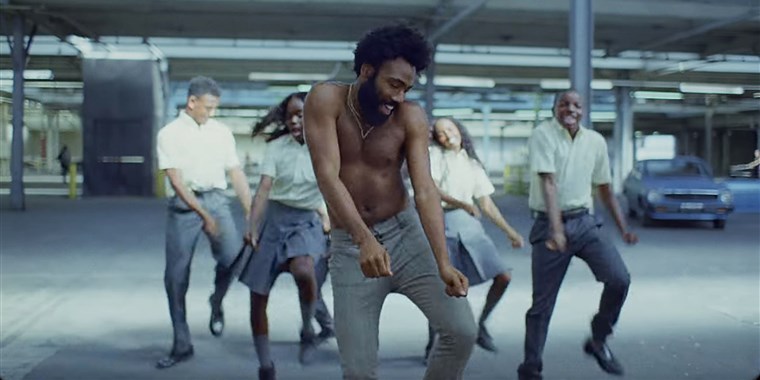This is America: a musical commentary on the American reality
May 30, 2018
Music, arguably the most popular and most accessible form of art today, has the unique power to uplift, comfort, or inspire. In some rare cases, music can cause individuals to question their deepest values and the world around them.
Evidently, Donald Glover, known by his stage name Childish Gambino, has accomplished the latter with his newest single “This is America.”
Featuring on music charts and news headlines around the world, “This is America” has become the subject of daily conversation. But more interestingly, 68 percent of the total streaming of the song come from YouTube views. The video itself has gained over 170 million views in under three weeks. “This is America” demands the visual aid of the music video in order to be reach its fullest impact.
The music video was released simultaneously as Childish Gambino both hosted and featured as the musical guest on Saturday Night Live. The video is hardly something that can just be played in the background, or viewed inattentively. Multiple watchthroughs are necessary in order to catch all that’s going on, as countless hidden messages are scattered throughout the four minute duration.
The video opens with a eerily joyous tone, with a man seated in an empty warehouse playing the guitar. Many viewers were quick to point out similarities in his appearance to the father of Trayvon Martin, an African American teen who was shot and killed by a police officer at the age of 17. However, the camera quickly pans to Childish Gambino, who dances towards the man and assumes a stance reminiscent of posters of historical depictions of Jim Crow, a character popular in the late 1800’s who depicted racist interpretations of African American culture. Suddenly, Childish Gambino shoots the man with the guitar point blank. Immediately, it is clear the video takes a dark turn as chaos begins to fill the warehouse.
Childish Gambino begins to dance with a group of school aged children, a representation of how entertainment, specifically by African American artists, is used to distract from the deeper issues in our country. The use of children as background dancers also implies how African American children are raised living this reality.
Later, a choir is shown in frame, singing and dancing amidst the chaos. Childish Gambino enters through a door and begins to sway along with them. Suddenly, an assault type rifle is thrown to him, and he guns down the choir. In both this shooting and previously where Childish Gambino shoots the man with the guitar, after the weapon is fired, it is carefully handled with red cloth while the dead bodies are either dragged out of frame or left crumpled on the floor. This is a clear commentary of how America values guns more than human lives.
The dancing with school children resume, as fires and destruction continue in the background. At one moment, a man falls from the upstairs railing down onto a car. Viewers identified this as a commentary on the stigma around suicide, particularly for African American males. The shot pans up to a group of teens holding their phones out towards the chaos, as if they were recording the violence. This double entendre symbolizes how social media has become a distraction, and how many are more interested in filming injustices rather than taking proactive action, but also how modern technology has become a way to bring serious discrimination to public attention.
As the video approaches its end, the music and Childish Gambino both halt. He lights a cigarette and walks towards an arrangement of cars, each decades old, where he climbs on top of one of them. This occurs during 17 seconds of silence, where many viewers were quick to point this out as a nod to the 17 victims of the Marjory Stoneman Douglass shooting. The agedness of the vehicles are symbolic of how America is unprogressive, struggling through the same issues of police brutality and racial bias as they have for decades, with little clear progress.
Childish Gambino begins dancing on the roof of a car as the shot widens and pulls away. Viewers also identified this as a nod to Michael Jackson’s “Black or White” music video, which was a notable racial and social commentary during its release. The arrangement of cars paired with the chaos from the video earlier could also be a nod to the 1992 LA riots, where over one billion dollars of damage were caused in the streets of Los Angeles in response to unjust violence against African Americans by the Los Angeles Police Department.
Finally, the video cuts to black. The camera pans up, following Childish Gambino running sporadically down a long, dimly lit coordinator, as if he was running for his life. Anguish and desperation are evident on his face as he is chased by a mob of people. The screen cuts back to black as the music video comes to a close.
As the global hype around “This is America” continued building, Donald Glover promoted his new movie, “Solo: A Star Wars Story”. In one press interview, Glover was asked to explain the meaning behind “This is America.” He simply replied, “No… I feel like it’s not really my place to do that. […] I think it’s something that should just be out there. It’s for the people.”
Undoubtedly, there are references and hidden meanings throughout the video that were not mentioned before, or may not have even been noticed yet. From smaller nods to history to the African American experience, “This is America” is an important commentary that all people regardless of race or nationality can, and should) learn from.
Watch the full music video below:
